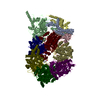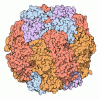[English] 日本語
 Yorodumi
Yorodumi- EMDB-11028: CryoEM structure of Rubisco Activase with its substrate Rubisco f... -
+ Open data
Open data
- Basic information
Basic information
| Entry | Database: EMDB / ID: EMD-11028 | |||||||||
|---|---|---|---|---|---|---|---|---|---|---|
| Title | CryoEM structure of Rubisco Activase with its substrate Rubisco from Nostoc sp. (strain PCC7120) | |||||||||
 Map data Map data | ||||||||||
 Sample Sample |
| |||||||||
 Keywords Keywords | AAA+ / beta barrel / CHAPERONE | |||||||||
| Function / homology |  Function and homology information Function and homology informationphotorespiration / carboxysome / ribulose-bisphosphate carboxylase / ribulose-bisphosphate carboxylase activity / reductive pentose-phosphate cycle / monooxygenase activity / magnesium ion binding / ATP hydrolysis activity / ATP binding Similarity search - Function | |||||||||
| Biological species |  Nostoc sp. PCC 7120 = FACHB-418 (bacteria) / Nostoc sp. PCC 7120 = FACHB-418 (bacteria) /  Nostoc sp. (strain PCC 7120 / SAG 25.82 / UTEX 2576) (bacteria) Nostoc sp. (strain PCC 7120 / SAG 25.82 / UTEX 2576) (bacteria) | |||||||||
| Method | single particle reconstruction / cryo EM / Resolution: 2.86 Å | |||||||||
 Authors Authors | Wang H / Bracher A | |||||||||
 Citation Citation |  Journal: Cell / Year: 2020 Journal: Cell / Year: 2020Title: Dual Functions of a Rubisco Activase in Metabolic Repair and Recruitment to Carboxysomes. Authors: Mirkko Flecken / Huping Wang / Leonhard Popilka / F Ulrich Hartl / Andreas Bracher / Manajit Hayer-Hartl /  Abstract: Rubisco, the key enzyme of CO fixation in photosynthesis, is prone to inactivation by inhibitory sugar phosphates. Inhibited Rubisco undergoes conformational repair by the hexameric AAA+ chaperone ...Rubisco, the key enzyme of CO fixation in photosynthesis, is prone to inactivation by inhibitory sugar phosphates. Inhibited Rubisco undergoes conformational repair by the hexameric AAA+ chaperone Rubisco activase (Rca) in a process that is not well understood. Here, we performed a structural and mechanistic analysis of cyanobacterial Rca, a close homolog of plant Rca. In the Rca:Rubisco complex, Rca is positioned over the Rubisco catalytic site under repair and pulls the N-terminal tail of the large Rubisco subunit (RbcL) into the hexamer pore. Simultaneous displacement of the C terminus of the adjacent RbcL opens the catalytic site for inhibitor release. An alternative interaction of Rca with Rubisco is mediated by C-terminal domains that resemble the small Rubisco subunit. These domains, together with the N-terminal AAA+ hexamer, ensure that Rca is packaged with Rubisco into carboxysomes. The cyanobacterial Rca is a dual-purpose protein with functions in Rubisco repair and carboxysome organization. | |||||||||
| History |
|
- Structure visualization
Structure visualization
| Movie |
 Movie viewer Movie viewer |
|---|---|
| Structure viewer | EM map:  SurfView SurfView Molmil Molmil Jmol/JSmol Jmol/JSmol |
| Supplemental images |
- Downloads & links
Downloads & links
-EMDB archive
| Map data |  emd_11028.map.gz emd_11028.map.gz | 16.7 MB |  EMDB map data format EMDB map data format | |
|---|---|---|---|---|
| Header (meta data) |  emd-11028-v30.xml emd-11028-v30.xml emd-11028.xml emd-11028.xml | 24.4 KB 24.4 KB | Display Display |  EMDB header EMDB header |
| FSC (resolution estimation) |  emd_11028_fsc.xml emd_11028_fsc.xml | 12.7 KB | Display |  FSC data file FSC data file |
| Images |  emd_11028.png emd_11028.png | 195.3 KB | ||
| Filedesc metadata |  emd-11028.cif.gz emd-11028.cif.gz | 7.7 KB | ||
| Others |  emd_11028_additional.map.gz emd_11028_additional.map.gz | 11.8 MB | ||
| Archive directory |  http://ftp.pdbj.org/pub/emdb/structures/EMD-11028 http://ftp.pdbj.org/pub/emdb/structures/EMD-11028 ftp://ftp.pdbj.org/pub/emdb/structures/EMD-11028 ftp://ftp.pdbj.org/pub/emdb/structures/EMD-11028 | HTTPS FTP |
-Validation report
| Summary document |  emd_11028_validation.pdf.gz emd_11028_validation.pdf.gz | 189.3 KB | Display |  EMDB validaton report EMDB validaton report |
|---|---|---|---|---|
| Full document |  emd_11028_full_validation.pdf.gz emd_11028_full_validation.pdf.gz | 188.8 KB | Display | |
| Data in XML |  emd_11028_validation.xml.gz emd_11028_validation.xml.gz | 501 B | Display | |
| Data in CIF |  emd_11028_validation.cif.gz emd_11028_validation.cif.gz | 450 B | Display | |
| Arichive directory |  https://ftp.pdbj.org/pub/emdb/validation_reports/EMD-11028 https://ftp.pdbj.org/pub/emdb/validation_reports/EMD-11028 ftp://ftp.pdbj.org/pub/emdb/validation_reports/EMD-11028 ftp://ftp.pdbj.org/pub/emdb/validation_reports/EMD-11028 | HTTPS FTP |
-Related structure data
| Related structure data |  6z1fMC  6hasC  6z1dC  6z1eC  6z1gC M: atomic model generated by this map C: citing same article ( |
|---|---|
| Similar structure data |
- Links
Links
| EMDB pages |  EMDB (EBI/PDBe) / EMDB (EBI/PDBe) /  EMDataResource EMDataResource |
|---|---|
| Related items in Molecule of the Month |
- Map
Map
| File |  Download / File: emd_11028.map.gz / Format: CCP4 / Size: 178 MB / Type: IMAGE STORED AS FLOATING POINT NUMBER (4 BYTES) Download / File: emd_11028.map.gz / Format: CCP4 / Size: 178 MB / Type: IMAGE STORED AS FLOATING POINT NUMBER (4 BYTES) | ||||||||||||||||||||||||||||||||||||||||||||||||||||||||||||||||||||
|---|---|---|---|---|---|---|---|---|---|---|---|---|---|---|---|---|---|---|---|---|---|---|---|---|---|---|---|---|---|---|---|---|---|---|---|---|---|---|---|---|---|---|---|---|---|---|---|---|---|---|---|---|---|---|---|---|---|---|---|---|---|---|---|---|---|---|---|---|---|
| Projections & slices | Image control
Images are generated by Spider. | ||||||||||||||||||||||||||||||||||||||||||||||||||||||||||||||||||||
| Voxel size | X=Y=Z: 0.8512 Å | ||||||||||||||||||||||||||||||||||||||||||||||||||||||||||||||||||||
| Density |
| ||||||||||||||||||||||||||||||||||||||||||||||||||||||||||||||||||||
| Symmetry | Space group: 1 | ||||||||||||||||||||||||||||||||||||||||||||||||||||||||||||||||||||
| Details | EMDB XML:
CCP4 map header:
| ||||||||||||||||||||||||||||||||||||||||||||||||||||||||||||||||||||
-Supplemental data
-Additional map: #1
| File | emd_11028_additional.map | ||||||||||||
|---|---|---|---|---|---|---|---|---|---|---|---|---|---|
| Projections & Slices |
| ||||||||||||
| Density Histograms |
- Sample components
Sample components
+Entire : NosRca-deltaC:Rubisco complex
+Supramolecule #1: NosRca-deltaC:Rubisco complex
+Supramolecule #2: AAA-core of the Rca hexamer from Nostoc sp. PCC7120 in complex wi...
+Supramolecule #3: Rubisco complex from Nostoc sp. PCC7120 in complex with inhibitor CABP
+Macromolecule #1: Ribulose bisphosphate carboxylase/oxygenase activase
+Macromolecule #2: Ribulose bisphosphate carboxylase large chain
+Macromolecule #3: Ribulose bisphosphate carboxylase small chain
+Macromolecule #4: ADENOSINE-5'-DIPHOSPHATE
+Macromolecule #5: PHOSPHOTHIOPHOSPHORIC ACID-ADENYLATE ESTER
+Macromolecule #6: MAGNESIUM ION
+Macromolecule #7: 2-CARBOXYARABINITOL-1,5-DIPHOSPHATE
-Experimental details
-Structure determination
| Method | cryo EM |
|---|---|
 Processing Processing | single particle reconstruction |
| Aggregation state | particle |
- Sample preparation
Sample preparation
| Concentration | 2.2 mg/mL | ||||||||||||||||||||||||||||||
|---|---|---|---|---|---|---|---|---|---|---|---|---|---|---|---|---|---|---|---|---|---|---|---|---|---|---|---|---|---|---|---|
| Buffer | pH: 8.4 Component:
| ||||||||||||||||||||||||||||||
| Grid | Model: Quantifoil R2/1 / Material: COPPER / Mesh: 300 / Support film - Material: CARBON / Support film - topology: HOLEY ARRAY / Pretreatment - Type: GLOW DISCHARGE / Pretreatment - Time: 30 sec. / Pretreatment - Atmosphere: AIR | ||||||||||||||||||||||||||||||
| Vitrification | Cryogen name: ETHANE / Chamber humidity: 90 % / Chamber temperature: 298 K / Instrument: FEI VITROBOT MARK IV | ||||||||||||||||||||||||||||||
| Details | NosRubisco (1 uM) was incubated with NaHCO3 (10 mM) at 298 K for 10 min followed by addition of CABP (8 uM). CABP-inhibited NosRubisco (0.5 uM) was then incubated with NosRcaDC (10 uM) in the presence of ATP (2 mM) for 10 s, followed by the addition of ATP-gammaS (2 mM), and incubated at 298 K for another 10 min before preparing the cryo-grids. |
- Electron microscopy
Electron microscopy
| Microscope | FEI TITAN KRIOS |
|---|---|
| Image recording | Film or detector model: GATAN K3 (6k x 4k) / Number grids imaged: 1 / Number real images: 9042 / Average exposure time: 2.8 sec. / Average electron dose: 60.0 e/Å2 / Details: 31 frames per image |
| Electron beam | Acceleration voltage: 300 kV / Electron source:  FIELD EMISSION GUN FIELD EMISSION GUN |
| Electron optics | Illumination mode: SPOT SCAN / Imaging mode: BRIGHT FIELD |
| Experimental equipment |  Model: Titan Krios / Image courtesy: FEI Company |
+ Image processing
Image processing
-Atomic model buiding 1
| Refinement | Space: RECIPROCAL / Protocol: OTHER |
|---|---|
| Output model |  PDB-6z1f: |
 Movie
Movie Controller
Controller












 Z (Sec.)
Z (Sec.) Y (Row.)
Y (Row.) X (Col.)
X (Col.)


































